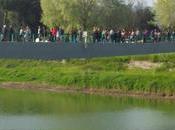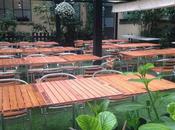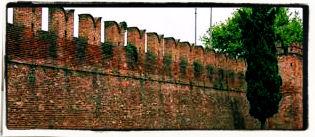
mura del castello
In my wanderings I came across a lost small village in the Lombard countryside. The sky, although it didn’t look very promising, created a picturesque landscape with the whole. It always amazes me to see how these small Italian villages seem to appear out of the thin air, giving us the wonderful surprises. I will not go on and on and I’m going to introduce you the pleasant country in Gambolò.Geographically speaking Gambolò is located in the heart of the Lomellina, not far from the Ticino river.
This little village has some hamlets: the main center, Remondò, Garbana and Belcreda. Even if this small village is the middle of the Lombardy countryside, it seems that the human presence in this area dated back to the Mesolithic Recent ( 5500-4500 BC ) and in the Bronze Age the demographic presence has increased, reaching a population density interesting during the Celtic age. There were already the Celts during the Caesar age. Indeed he identified the presence of the Celts (there were many tribes in Italy, France and England) and of the Germans in his De Bello Gallico.
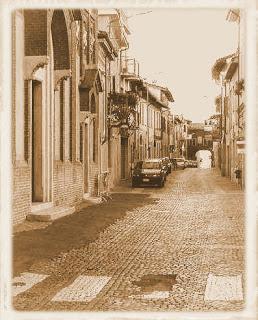
one street of the Gambolò
In any case there is the presence of an architectural structure dated back to the Roman era. It is now in the most recent structure of the Church of Sant.Eusebio. The castle- perhaps the main attraction of this village- was build in the Middle Age. Now you can visit it going to eat at the famous restaurant of the castle. This restaurant is delicious and they will spoil you. I have eaten there and I'm sure I'll be back: that day I have taken shelter there because it has begun to rain. I took the opportunity to make a tasty break because it was lunch time. Luckily it rained only while I was eating and then it was cleared up.The first time the official name of Gambolò appeared on an official document was in 999 in a dispute between Da Gambolate family and the bishop of Vercelli. There were the families Da Belcredio e Da Gambolate (they gave the name to the hamlets). Gambolò was damaged and invaded many times by the army from Milan between the XII and XIII centuries – this city was under the Visconti’s administration. Gambolò became a very populous village until the Renaissance, then it came under the dominion of Vigevano. The small village was also active during the Risorgimento, even if the main economical activity was the agriculture.
If you are in this small village, I suggest you to visit: -
Parrocchia di S. Gaudenzio ed Eusebio
- Il castello ( potete mangiare nel ristorante) e poi circumnavigare le mura - Il monumento a S. Getulio - La chiesa di Sant’Eusebio - il Molino di Isella
The agriculture stays the main activity. If you stroll around the streets of Gambalò a Sundays you can hear your footsteps on the pavement and you can enjoy the calm – it is absolutely unnatural in a city like Milan but here it is so pleasing!
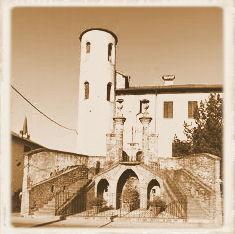
the castle
Nel mio girovagare mi sono imbattuta in un pesino sperduto nella campagna Lombarda. Il cielo, nonostante fosse poco promettente, creava un paesaggio suggestivo con l’insieme. Mi stupisce sempre vedere come questi piccoli borghi italiani sembrano compaiano dal nulla per poi regalarci delle magnifiche sorprese. Non mi dilungo oltre e vi presento l’ameno paese di Gambolò. Geograficamente parlando Gambolò si trova nel cuore della Lomellina, poco distante dal Ticino. Questo comune è composto da varie frazioni che sono : il centro principale, Remondò, Garbana e Belcreda. Per quanto piccolo e sperduto per la campagna lombarda pare che la presenza dell’uomo in quest’area risalisse addirittura al Mesolitico Recente quindi 5500-4500 a.C. e nell’età del bronzo si sia incrementata , raggiungendo una densità demografica interessante in età celtica. I celti erano già presente ai tempi di Cesare, che identificava nel suo De Bello Gallico la loro presenza ( vi erano numerose tribù in Italia, Francia, fin all’Inghilterra) e la presenza dei Germani. In ogni caso pare che risalga all’epoca romana la presenza di una struttura architettonica i cui resti sono ore appartenenti alla più recente struttura della Chiesa di Sant.Eusebio. Bisogna aspettare l’epoca medievale per la nascita del castello, forse l’attrazione principale di questo borgo,che potrete godere appieno andando a mangiare nel famoso ristorante del castello. Questo locale è delizioso e vi vizieranno. Io l’ho provato e sono sicura che ci tornerò: mi ci sono rifugiata perché ha incominciato a piovere e visto che era ora di pranzo, ho approfittato per fare una piacevole pausa. Fortuna vuole che abbia piovuto giusto mentre mangiavo e poi il cielo si fosse rischiarato. La prima volta che appare il nome ufficiale di Gambolò è nel 999 per un diverbio con il vescovo di Vercelli. Pare che esistessero le famiglie Da Belcredio e Da Gambolate ( che se vogliamo vedere sono sicuramente gli abitanti di due delle frazioni di questo borgo). Gambolò fu danneggiata e più volte invasa dai milanesi tra il XII e il XIII secolo con una ovvia vittoria di Milano che allora era governata dai Visconti. Gambolò divenne un borgo molto popoloso fino a quando nel Rinascimento entrò far parte del dominio di Vigevano. Il piccolo borgo fu attivo anche durante il risorgimento, pur dedicandosi sempre alla sua attività principale che era l’agricoltura. Se vi trovate in questo paese vi suggerisco di vistare : - Parrocchia di S. Gaudenzio ed Eusebio - Il castello ( potete mangiare nel ristorante) e poi circumnavigare le mura - Il monumento a S. Getulio - La chiesa di Sant’Eusebio - il Molino di IsellaOggi ovviamente vive di agricoltura in prevalenza. Girare la domenica per questo paesino è molto piacevole perché si può sentir e il rumore dei propri passi sul selciato e godere di una calma che in città è assolutamente innaturale ma così piacevole!
